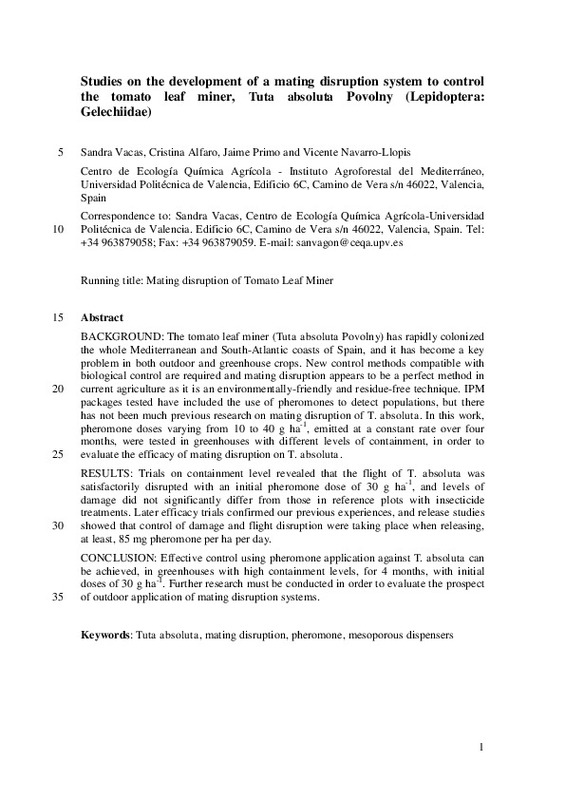Vacas González, S.; Alfaro Cañamás, C.; Primo Millo, J.; Navarro-Llopis, V. (2011). Studies on the development of a mating disruption system to control the tomato leafminer, Tuta absoluta Povolny (Lepidoptera: Gelechiidae). Pest Management Science. 67(11):1473-1480. doi:10.1002/ps.2202
Por favor, use este identificador para citar o enlazar este ítem: http://hdl.handle.net/10251/80293
|
Título:
|
Studies on the development of a mating disruption system to control the tomato leafminer, Tuta absoluta Povolny (Lepidoptera: Gelechiidae)
|
|
Autor:
|

 Vacas González, Sandra
Alfaro Cañamás, Cristina
Vacas González, Sandra
Alfaro Cañamás, Cristina

 Primo Millo, Jaime
Primo Millo, Jaime

 Navarro-Llopis, Vicente
Navarro-Llopis, Vicente
|
|
Entidad UPV:
|
Universitat Politècnica de València. Instituto Agroforestal Mediterráneo - Institut Agroforestal Mediterrani
Universitat Politècnica de València. Escuela Técnica Superior de Ingenieros Industriales - Escola Tècnica Superior d'Enginyers Industrials
|
|
Fecha difusión:
|
|
|
Resumen:
|
BACKGROUND: The tomato leafminer (Tuta absoluta Povolny) has rapidly colonised the whole Mediterranean and South-Atlantic coasts of Spain, and it has become a key problem in both outdoor and greenhouse crops. New control ...[+]
BACKGROUND: The tomato leafminer (Tuta absoluta Povolny) has rapidly colonised the whole Mediterranean and South-Atlantic coasts of Spain, and it has become a key problem in both outdoor and greenhouse crops. New control methods compatible with biological control are required, and mating disruption appears to be a perfect method in current agriculture, as it is an environmentally friendly and residue-free technique. IPM packages tested have included the use of pheromones to detect populations, but there has not been much previous research on mating disruption of T. absoluta. In this work, pheromone doses varying from 10 to 40 g ha(-1), emitted at a constant rate over 4 months, were tested in greenhouses with different levels of containment in order to evaluate the efficacy of mating disruption on T. absoluta.
RESULTS: Trials on containment level revealed that the flight of T. absoluta was satisfactorily disrupted with an initial pheromone dose of 30 g ha(-1), and levels of damage did not significantly differ from those in reference plots with insecticide treatments. Later efficacy trials confirmed previous experiences, and release studies showed that control of damage and flight disruption were taking place when releasing at least 85 mg pheromone per ha per day.
CONCLUSION: Effective control using pheromone application against T. absoluta can be achieved, in greenhouses with high containment levels, for 4 months, with initial doses of 30 g ha(-1). Further research must be conducted in order to evaluate the prospect of outdoor application of mating disruption systems.
[-]
|
|
Palabras clave:
|
Mating disruption
,
Mesoporous dispensers
,
Pheromone
,
Tuta absoluta
,
Sex pheromone
,
Colonization
,
Greenhouse ecosystem
,
Insecticide
,
Integrated pest management
,
Leafminer
,
Pest damage
,
Animal
,
Article
,
Drug effect
,
Economics
,
Evaluation
,
Female
,
Insect control
,
Male
,
Methodology
,
Moth
,
Sexual behavior
,
Spain
,
Tomato
,
Animals
,
Lycopersicon esculentum
,
Moths
,
Sex Attractants
,
Sexual Behavior, Animal
,
Atlantic Ocean
,
Atlantic Ocean (South)
,
Mediterranean Sea
,
Agromyzidae
,
Gelechiidae
,
Lepidoptera
|
|
Derechos de uso:
|
Reserva de todos los derechos
|
|
Fuente:
|
Pest Management Science. (issn:
1526-498X
)
|
|
DOI:
|
10.1002/ps.2202
|
|
Editorial:
|
Wiley
|
|
Versión del editor:
|
http://dx.doi. org/10.1002/ps.2202
|
|
Tipo:
|
Artículo
|






![[Cerrado]](/themes/UPV/images/candado.png)



